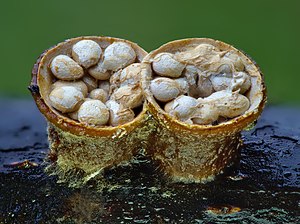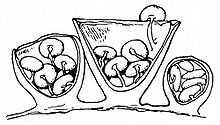Common crucible dearling
| Common crucible dearling | ||||||||||||
|---|---|---|---|---|---|---|---|---|---|---|---|---|

Common Crucibulum Laeve ( Crucibulum laeve ) |
||||||||||||
| Systematics | ||||||||||||
|
||||||||||||
| Scientific name | ||||||||||||
| Crucibulum laeve | ||||||||||||
| ( Huds. ) Kambly |
The common crucible ( Crucibulum laeve , Syn .: C. vulgare ) is a type of mushroom from the mushroom relatives family . He is the only genre representative in Germany. The common crucible guerrilla was named mushroom of the year 2014 by the German Society for Mycology .
features
Macroscopic features
The initially spherical fruiting bodies later stretch out in the shape of a barrel and finally spread out in the shape of a pan. They reach a height of 1 cm. The walls of the closed spore containers ( peridia ) are clad in white felting when they are young and are closed at the top with a yellow to orange or ocher-colored and felt-like-flaky structured lid ( epiphragma ). The membrane tears as it grows - the residues adhering to the edge are volatile and have disappeared in older fruiting bodies. Inside are lenticular bundles of spores ( peridioles ). They measure 1–1.5 mm in diameter and are attached to the smooth and whitish to yellowish inside with a fine tramastang ( funiculum ).
Microscopic features
The 8–11.5 × 4.5–6 micrometers large spores are hyaline and elliptical in shape. The spore wall is thick and smooth.
Species delimitation
The “real” dearlings ( Cyathus ) have no yellowish-orange colors and instead of a lid, a white membrane is stretched over the opening. In addition, they have a more simply structured tramastric cords on the peridioles and a 3-layer instead of 1-layered peridia. The significantly rarer stuffed nestling ( Nidularia deformis ) has no epiphragma. Ripe fruit bodies are dark brown in color.
Ecology and phenology
The crucible duckling lives as a saprobiont on scraps of wood, twigs and cones of various deciduous and coniferous woods. The species can also be found on plant stems and rotten thatched roofs. Sometimes it also colonizes the ground. The fungus occurs in different forest types, often on the edges of the forest or on clear-cuts, less often in gardens or on pastures.
The fruiting bodies of the crucible starling appear from June to October.
meaning
The species has no food value and is economically insignificant.
swell
literature
- Ewald Gerhardt: FSVO manual mushrooms . 3. Edition. BLV, Munich 2002, ISBN 978-3-405-14737-2 (639 pages; one-volume new edition of the BLV intensive guide mushrooms 1 and 2).
- German Josef Krieglsteiner (Eds.), Andreas Gminder , Wulfard Winterhoff: Die Großpilze Baden-Württemberg . Volume 2: Stand mushrooms: inguinal, club, coral and stubble mushrooms, belly mushrooms, boletus and deaf mushrooms. Ulmer, Stuttgart 2000, ISBN 3-8001-3531-0 .
Individual proof
- ↑ Bruno Hennig, Hans Kreisel, Edmund Michael: Non-leaf mushrooms (Basidiomycetes without leaves, Ascomycetes) . In: Handbook for mushroom lovers . 3. Edition. tape 2 . VEB Gustav Fischer, Jena 1986.
Web links
- Michael Kuo: Crucibulum laeve. In: MushroomExpert.Com . Retrieved August 15, 2012 .
- Frank Moser: Crucible dearling. In: Natur-Lexikon.com . Retrieved August 15, 2012 .



